Reclaimed Doll Dress On Form
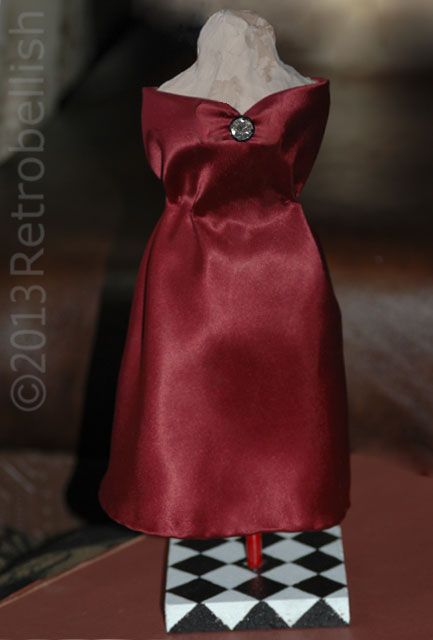
Throughout the years I have bought several interesting dolls at craft shows and garage sales. One of my doll’s had a dreary dress and for the longest time, I’ve wanted to make that doll a prettier dress. To make it easier to work on the dress, I decided to make a dress form as close as possible to the doll’s size. The form started out from a piece of reclaimed aluminum foil that I rolled up into an oblong shape. I then took old newspaper strips, made paper mache and wrapped the paper mache strips around the foil. Paper mache forms are sold at most craft stores, but are usually smaller in size. I needed this form to be approximately the same size as the doll, so making my own form was the best option and it also gave me a chance to use up some recyclable items I had lying around the house.
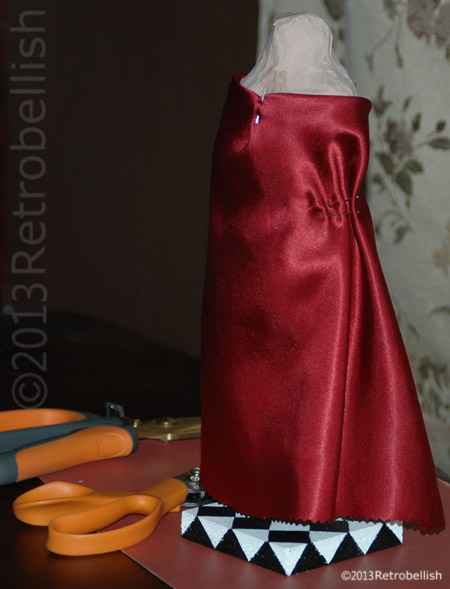
I was quite happy that the form I made was very close in size to the doll’s size. I then needed to make a stand and a base. Once the form was thoroughly dry, I drilled a small hole into the bottom center of the form and into the square wood base I had found in my garage. Using my hot glue gun, I put some hot glue onto both ends of an old pencil and stuck the pencil into the drilled hole and into the base. Once the hot glue dried, I used a light tan acrylic craft paint to paint the paper mache form.
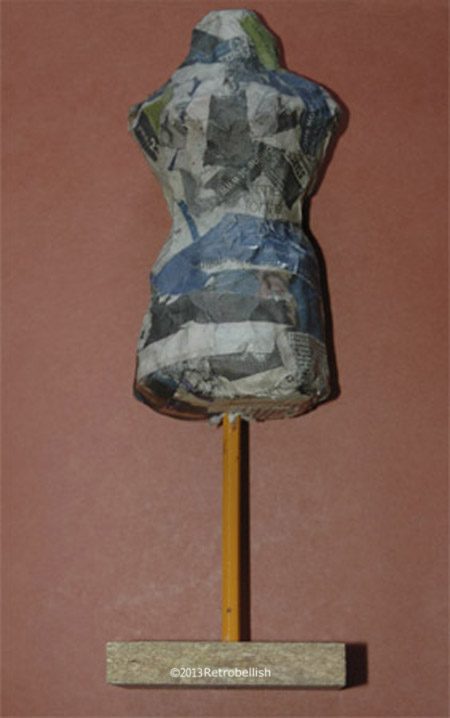
I had picked out a beautiful deep satin red fabric from my old fabric remnants to make the doll’s dress, a color that I thought looked very nice in contrast to the form’s tan color. I then decided to use acrylic craft paints to create a harlequin black and white pattern on the base. Once the base was painted in white and the paint dried, I cut out black little squares from an old calendar I was about to recycle. By trial and error, I found the right size little squares for the harlequin print on the base and used a pencil to trace the little squares. I then used black acrylic paint to paint in the little squares. Once the base was thoroughly dry, I was finally ready to make the dress.
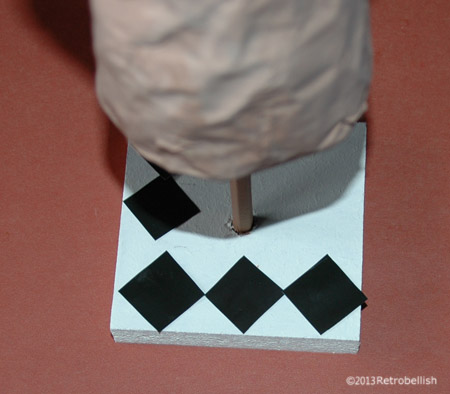
As you may have read on some of my previous posts, I love to make miniature dresses for dolls or just as art pieces. This project started out as a form for my doll’s dress, and although the red satin fabric lent itself to a much fancier dress than I intended for my doll, I decided to keep this evening dress as an art project on this stand. I used small snaps to fasten the back of this dress, so I plan to remove the dress, make a different style dress for my doll, and place the red dress back on this stand permanently as an art piece. To add a little sparkle to the top center of the dress, I used a small earring (a partner to the one I lost), but you can use any piece of jewelry you’d like.
So although I intended to use this form to help me make my doll’s dress, I was happy that I made an art piece to place in my sewing room, yet I will still be able to make my doll’s dress, and then display the red dress on my shelf as an art piece. Even though I chose to make my paper mache form, you could buy one and make your very own piece of art. Remember, just have fun and enjoy your crafts.
Reclaimed Fabric Jester Doll
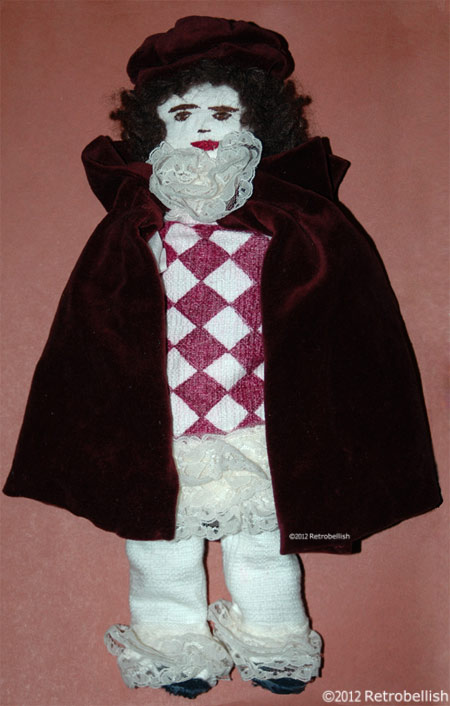
This little jester started out as an idea I had to make a medieval style doll about five years ago. I have always been inspired by the medieval style clothing from some of the great classic movies. The colors, the style and flow of the fabrics have always been a fascination of mine. A few weeks ago, while looking through my fabric remnants, I saw beautiful colors and lush textures that inspired me to make a jester doll.
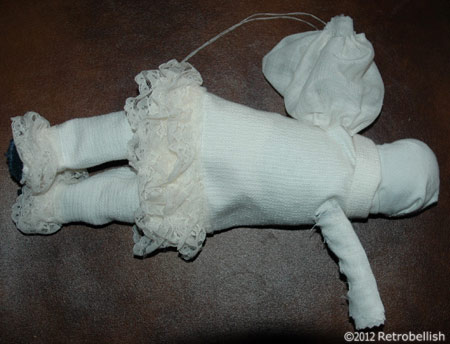
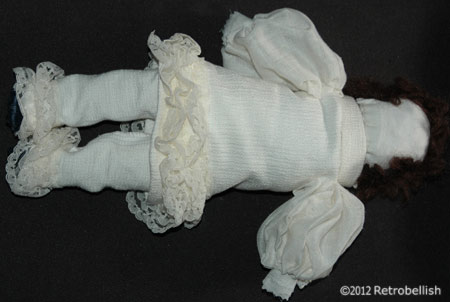
Completed Jester Body
First, I had to create the doll’s body and since this would be an abstract cloth doll, I decided to use the fabric from an old cotton sweatshirt. I cut a lengthy portion from one sweatshirt sleeve and rolled up the cut piece forming a firm makeshift torso and sewed the edges to the rolled up portion. Next I cut smaller pieces from the same sweatshirt, rolled up the piece to make an arm in the same fashion as the torso and repeated these steps to make the other arm. I then sewed each arm piece to each side near the top of the torso. I followed the same procedures to make the legs and sewed them to the bottom portion of the torso.
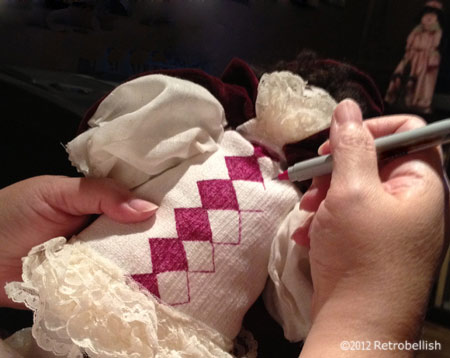
The head was challenging, but I used the same sweatshirt remnant from which I cut one lengthy piece. I rolled one long piece into a rounded ball shape and when big enough in proportion to the body, I pinned it in several spots and started sewing along all edges to secure the ball shape as much as possible. I cut apart old sheer knee high stockings and placed a piece over the round head shape, stuffed more cotton pieces at the base to make a neck and started sewing that part to the body. Next I looked through my remnant box and found a small piece of soft white cotton that was large enough to sew over the entire head. I took brown colored sewing thread to sew the jester’s eyes, eyebrows and nose. I used red sewing thread to make the lips. I then used brown curly wool trim to make the hair by sewing down the strips to the head.
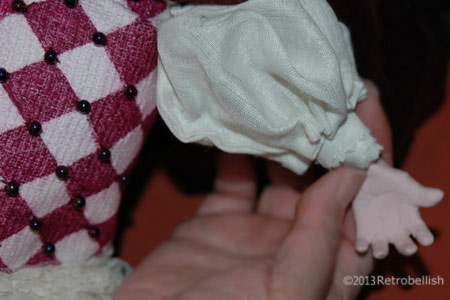
In my remnant fabric box, I found a beautiful cream colored cotton fabric, which was large enough to make the jester’s tunic, sleeves and pants. I spread the fabric out on a table and laid the doll flat over the folded fabric. By eye, I used a pencil to lightly trace around the doll creating a pattern on the fabric and (leaving a generous 1/2 inch seam allowance). I cut out the drawn pattern to sew the doll’s clothes. When I finally finished the jester’s clothes, I used a maroon colored permanent fabric marker to draw and color in a harlequin pattern onto the tunic. I had a roll of cream colored lace trim that perfectly matched the cream colored clothes. I used cream colored sheer cotton to separately make sleeves and connected them to the tunic at the shoulders and around the armholes.
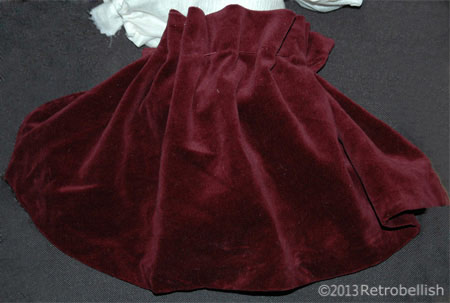
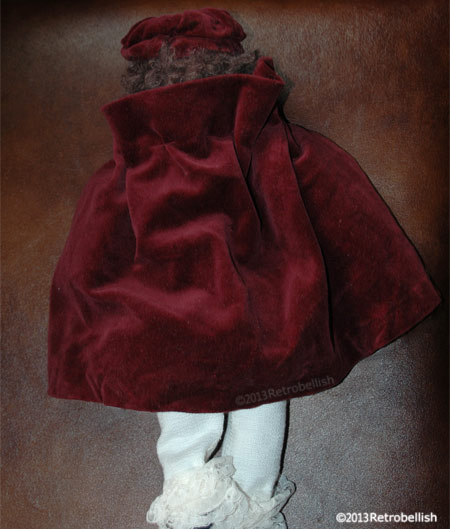
I also found a beautiful maroon colored velour fabric piece in my remnant box (cut from an old jacket of mine) and saw that it was perfect in size to make a cape for the doll. Using a matching maroon colored thread and needle, I basted long stitches about one inch from the cape’s top edge hemline. I sewed smaller single stitches down each side of the cape, placed it over the doll’s shoulders, and sewed a bottom hemline on the cape. Next, I decided to make a hat for the jester, so I took another maroon velour remnant and cut it into a trapezoid shape. I sewed together the longest edges forming a tubular shape (leaving the top and bottom ends open), and sewed the smaller opened side to the jester’s head (through the white fabric and hair), flattened down the rest of the tube while puffing out the fabric, which piled nicely forming a round puffy shape, sewed tiny stitches to hold the folds in place, and continued to form the hat as I went along. Then I sewed the center of the hat down through the center and hid those stitches under one of the folds of the last layer. I was very pleased with the results.
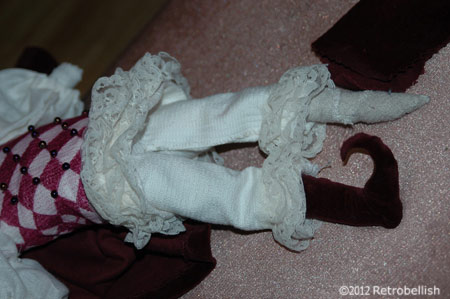
I adorned the harlequin pattern on the jester’s tunic by sewing on some maroon colored beads. I also made the jester’s boots from the same maroon velour fabric and sewed tight stitches to create the curled points on the boots.
Just like in some of the old movies I’d seen, I wanted the jester to be holding a mandolin. I looked up a picture of a mandolin on-line, drew it onto a piece of regular paper and figured out an appropriate size mandolin by holding it up against the jester. Once I figured out the correct size in proportion to the jester, I traced the mandolin pattern onto heavier paper and again onto corrugated cardboard. Next I measured where to make the center hole on the mandolin and used a paper punch to do so. Using acrylic craft paints, I painted the mandolin details onto the heavy paper pattern and let it dry.
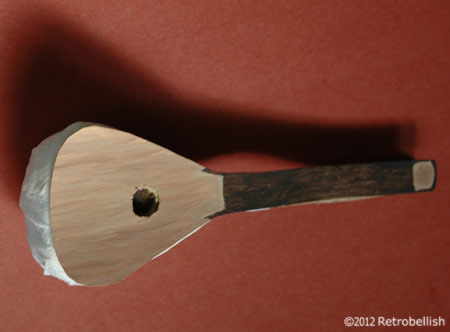
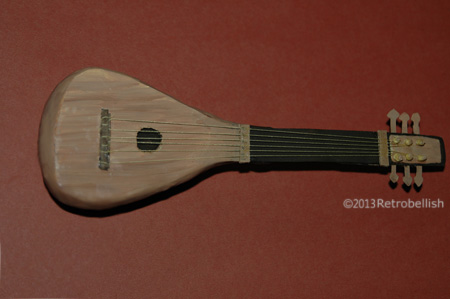
Next, I worked with the heavy corrugated cardboard mandolin and neck cutouts and glued them together. The lower back portion of the mandolin body was rounded (as if made from a hollowed out gourd). I achieved that look with paper mache (which I made from scrap paper towel strips watered down with white glue) and affixed that small round shape to the mandolin’s back by wrapping long narrow mache strips from the back and around to the front of the mandolin’s body. I then placed the mandolin on a piece of waxed paper and near the heating vent to dry. Once it dried overnight, I was able to remove the mandolin from the waxed paper without any problem. Next, I glued the painted mandolin paper veneer over the face of the heaver paper mache mandolin piece and painted the rest of the mandolin to match the already painted top veneer.
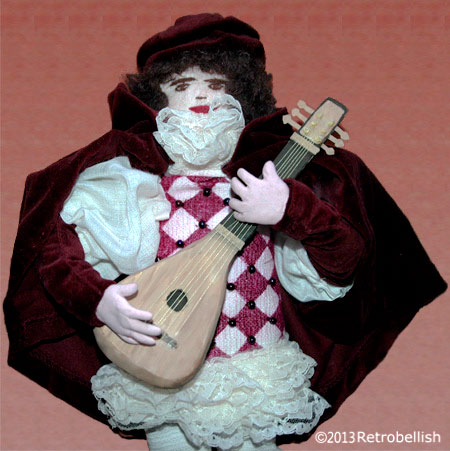
I cut small rectangular corrugated cardboard pieces to make the bridge and nut pieces on the mandolin, then used bright yellow sewing thread and fabric glue to adhere the strings onto the tiny rectangular bridge. Once the strings dried in place, I cut (with sharp scissors) the ends off of rounded toothpicks to make the tuning heads and pushed those cut pointy ends (dipped into a little glue) and into the head. Once they dried in place, I took one string at a time, dabbed glue around the tiny tuning heads and with tweezers, began wrapping each thread around its corresponding tuning head and cut off the excess. Once everything was dried, I placed the nut in place, and used glue to line up the strings evenly in place.
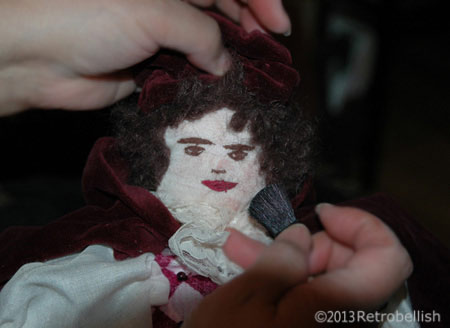
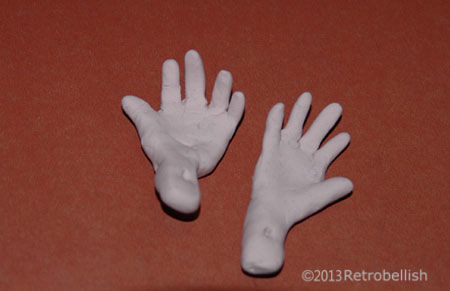
Last, but not least, I made the jester’s hands from flesh colored polymer clay. I rolled each finger and made some slightly longer or shorter matching the sizes for each hand. I made the palm part, a longer wrist part, pierced the end of the arm part with a toothpick (so that I could later sew the arm to the sweatshirt arm). I then attached the fingers onto the hand part and held them in front of me and while mimicking playing a guitar, curved the hands and shaped the fingers. I carefully placed the complete shaped pieces onto aluminum foil and baked them in the oven (carefully following the clay manufacturer’s instructions).
Although this project took me over a month to complete in my spare time, it can be done in several days with the right amount of time. And although I chose to make a jester doll, you could give it a try with any doll you’d like. So just have fun and create your own reclaimed fabric doll.
Make Your Own Earrings
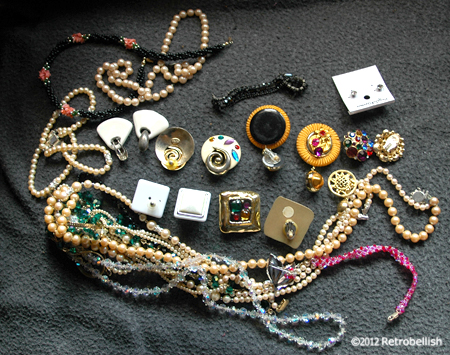
Earrings are one the easiest craft projects to make. I have always had a lot of fun making my own earnings, either from beads I already have on hand or from broken pieces I find at garage sales and thrift stores. Many years ago for my wedding, I wanted a simple pair of pearl earrings fashioned in a loop and preferably with very little sparkle, but could not find anything I really loved. After searching for so long, I decided to buy two different pair of earrings and use the pearls and pieces from the two to make my own.
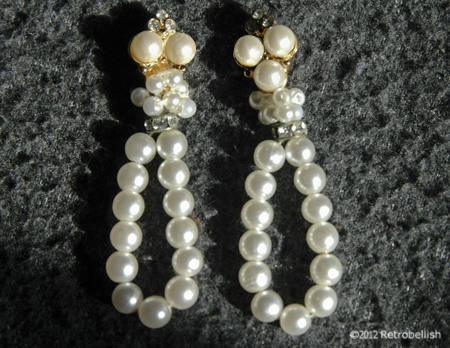
The neckline on my wedding dress was open with a scalloped edge that was decorated with small pearls and very few tiny sequins all the way around to my back. Because the neckline was so decorated, I was not going to wear any necklace and it was important that the earrings I wear have some length, but not be too bulky or sparkly. I wanted the long loops (which reminded me of the scalloped edge) to be made of small pearls matching (as close as possible) the size of the pearls on the scalloped edges of my dress. I really couldn’t find anything that even came close to what I imagined. Finally, I found what I was looking for in two pairs of earrings and knew I would to try and make my dream earrings. I was very satisfied with the results, and even received a few compliments.
Just because a necklace or bracelet is broken or outlived its luster, it doesn’t mean you can’t create your very own creation. So look at what you have on hand and let your imagination go wild, you will be surprised at what you can create. Have Fun!
Repurposed Floral Vase
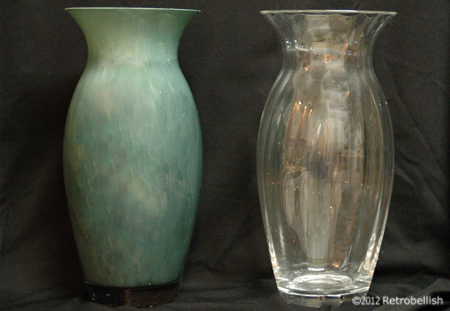
This glass vase started out as a gift from a close friend of ours. She gave us a set of two, but we were on the verge of a home remodeling project and decided not to open the vase boxes for fear of breaking them. When we finally decided to use the vases, we discovered one vase had a cracked rim, and by then too much time had gone by to exchange it.
So I decided to re-purpose the damaged vase as a painted glass vase. I started out by taking a trip to my local home improvement store to get all the items I needed for the project. Since the crack was only about a few inches long (in the shape of a half moon), I decided to just get some fine grade sandpaper to smooth off the broken glass edges. Also, I was able to purchase a small can of forest green acrylic enamel on clearance. I sanded the cracked rim until the sharpness was gone (wear gloves when doing this part) and the glass was smooth. I then painted the inside of the glass vase with the deep forest green paint I had purchased. I then let it dry for about a day. After the vase was completely dry, it looked like green glass and the crack was not as visible any more–perfect for some dry or silk flower arrangement.
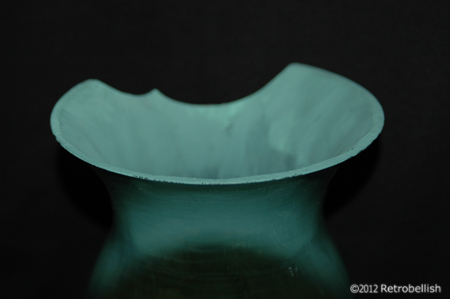
I decided to use some tall silk peonies I had purchased a few months back on one of my weekend trips to a small neighborhood craft store. The craft store mostly has a lot of bridal accessories, but always has great clearance sales on their floral supplies. The flowers I had were big and bulky, perfect for the size of the vase. The other green leafed pieces I had were leftovers from other projects. When I started to play around with the flowers and the greenery, it started to create a very lifelike arrangement that I decided to keep.
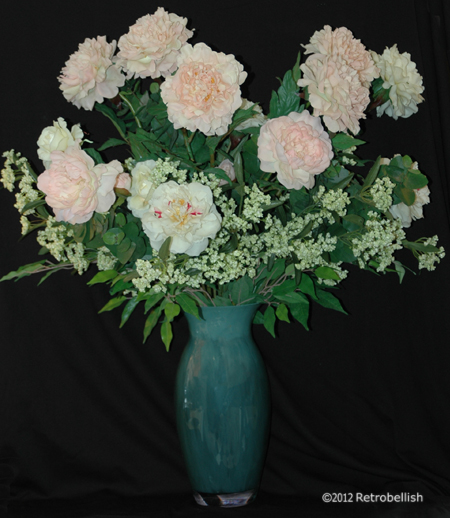
This vase could also have been painted in any color of your choice, even Mod Podged with old magazine cutouts or any art of your choice. This project could also be done on any glass vase to which you may want to give a new look. The beauty is that if you don’t like the color, it could be changed. So just have fun and create your very own one-of-a-kind piece.
Grapevine Holiday Wreath
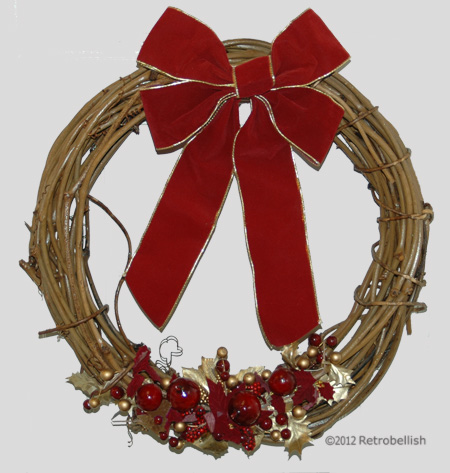
The holiday season is a fun time of the year to get creative with decorations for your home. This grapevine holiday wreath is very simple to make and could easily be updated every year with different ornaments of your choice. I had a very plain grapevine wreath at home that I wanted to decorate with some type of ornaments, but nothing too big that would hide the beauty of the vines.
Right after the holidays last year, I went to a craft store clearance sale and found some beautiful ornamental sprigs that I really loved. One of these sprigs was perfect because it had beautiful deep red berries and gold leaves that looked beautiful when I held them up against the wreath. I loved the look so much that I wired the sprig onto the wreath and decided that a bow at the top would balance out the wreath. I found a beautiful deep red bow with gold edging that complimented the sprig perfectly.
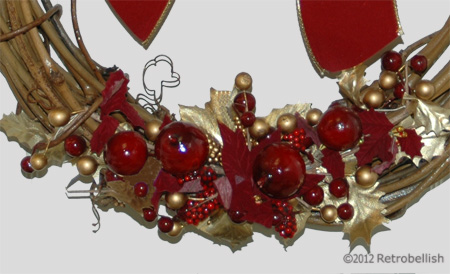
It felt wonderful to hang such a beautiful wreath on the door. These grapevine wreaths are very strong and versatile and lend themselves to many different types of decorating techniques. So just have fun and create your very own one-of-a-kind wreath.